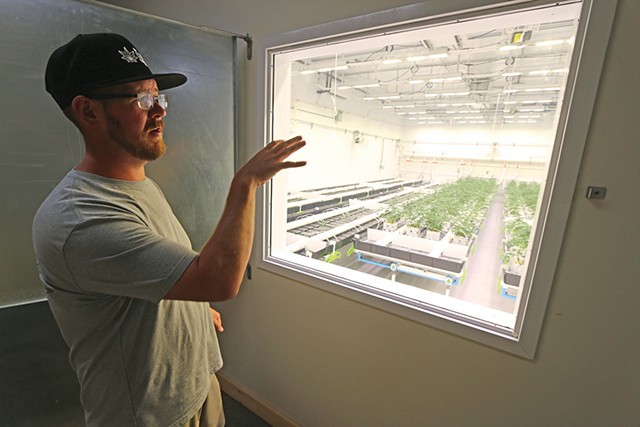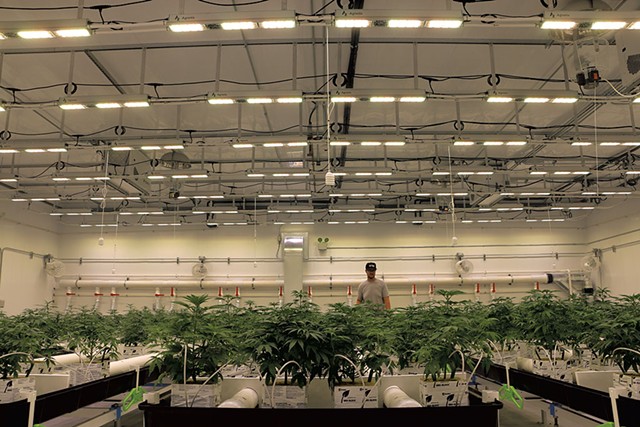
- Kevin Mccallum ©️ Seven Days
- Devin Dannat surveying the hemp crop in his Hardwick facility
Devin Dannat pushed open a sturdy metal door at his new Clean Cannabis Company building in Hardwick last week and stepped from a dim hallway into a luminous new world. Bright light burst forth from rows of overhead LED fixtures, bathing the 35-year-old budding entrepreneur and his hundreds of young hemp plants in a warm glow.
After a few more weeks soaking up the intense artificial rays, the verdant plants will flower, yielding the company's first crop of pungent buds grown for its cannabidiol, or CBD, the nonpsychoactive cannabis extract. Dannat and his partner, Derek Porter, expect to soon repeat the process with cannabis strains containing THC, which they plan to sell in the legal adult-use weed market, slated to open on October 1.
The powerful lighting and control system at the heart of the 12,000-square-foot grow operation is one of the most expensive on the market and cost the company nearly $450,000. To help them afford such cutting-edge technology, the men had angel investors of sorts — Vermont electricity ratepayers.
Their fledgling company received $77,000 in rebates from Efficiency Vermont, the Winooski-based energy efficiency utility. Most of that money was an incentive to reward them for choosing one of the most efficient lighting systems around.
"That definitely sweetened the deal for us," Dannat said.
As Vermont edges toward a legal recreational cannabis market, everyone paying a power bill is indirectly subsidizing the indoor cultivation of marijuana. Efficiency Vermont, established by lawmakers in 1999 and funded through charges on residential and commercial power bills, is working to blunt the power demand of the energy-intensive cannabis businesses taking root.
One way it's doing that is by reminding growers that the most energy-efficient way to cultivate cannabis is outdoors, where the sun and rain can work their magic naturally. Many growers nevertheless prefer the predictability and greater yields that indoor growing generates. In colder climates such as Vermont's, outdoor growers can generally enjoy one annual harvest, while indoor growers, using powerful artificial lights, can get up to four.
Efficiency Vermont has set aside $1 million for rebates that are meant to encourage indoor growers to install the most energy-efficient lighting, heating and cooling, and dehumidification systems possible. The 15 rebates approved so far vary widely depending on the size and sophistication of each operation but generally cover 30 to 40 percent of the additional cost of more efficient systems, explained Jeff Buell, a spokesperson for Efficiency Vermont. The goal is to help growers reduce their energy use, save money and keep energy costs down for other ratepayers, said Peter Walke, the program's managing director.
"By offering substantial technical support and incentives, Efficiency Vermont is able to do for Vermont's cannabis industry what we have done for commercial and industrial customers in all sectors: reduce the upfront cost to unlock long-term savings while reducing businesses' overall carbon footprint," Walke said in a written statement.
The program has offered incentives to farmers, mostly in the dairy industry, since the early 2000s, Buell said. In 2019, it also began offering rebates for home cannabis growers of $100 per qualifying light fixture. This year's budget represents a sharp increase in the organization's spending on indoor agriculture because the need has arisen, Buell said.
Average residential ratepayers pay about $6.65 per month in efficiency charges, which amounted to $43 million last year, the bulk of the program's $56 million budget, Buell said. Most of those funds are repaid to homeowners and businesses through a dizzying array of rebates covering everything from efficient windows and doors for homeowners to new refrigeration units for grocers to reverse osmosis systems for maple syrup producers.
While some black-market cannabis growers considering a transition to the new legal market are hesitant to share details of their operations with Efficiency Vermont, not doing so would leave money on the table, said Tito Bern, owner of the Bern Gallery head shop in Burlington. Bern plans to grow cannabis inside a 4,000-square-foot facility he's building in Addison County and to sell weed at his shop this fall.
"For my setup, they're going to give me $53,000," Bern said. "I couldn't even believe it!"
Efficiency Vermont experts reviewed his plans, gave him advice, and signed a deal to pay him the customized rebate amount once he installs and runs the equipment. It includes 50 LED arrays that Bern called "the Ferrari of grow lights," manufactured by a company called Fohse. The equipment also includes a dehumidification system that Bern said will pull moisture from the air, filter it and use it to irrigate his cannabis crop.
While the rebates haven't arrived yet, just knowing that they will cover about half the cost of the lights alone has been a huge boost.
"It helped me a shitload," Bern said.
The Vermont Cannabis Control Board has been tasked with helping set up and regulate the nascent industry. Ensuring that cannabis operations are financially and environmentally sustainable has been a priority for the state agency, commissioner Kyle Harris said.
"There have been environmental issues with the way cannabis has been regulated in the last 10 to 15 years," he said. "From an energy usage perspective, cannabis ranks fairly high."
Colorado legalized recreational cannabis in 2012. Electricity use from indoor cannabis cultivation in Denver grew from 1 percent of the city's electricity consumption in 2013 to 4 percent in 2018, according to the city. A 2021 study by Colorado State University researchers found that indoor cannabis had a high carbon footprint due to the electricity used for grow lights, fossil fuel to heat growing spaces, air conditioning to control temperature and humidity, and added carbon dioxide to help plants grow faster.

- Kevin Mccallum ©️ Seven Days
- Devin Dannat among his hemp plants under the LED light system
Aware of such environmental issues, the Vermont Cannabis Control Board set efficiency standards for licensed growers. Some of the guidelines are general, such as requiring buildings to meet commercial efficiency standards. Others are highly technical, such as the requirement that indoor cultivation lights "must have a minimum of 1.9 Photosynthetic Photon Efficacy (PPE)." That's basically a measure of how many photons the lights produce per watt.
The control board sought standards tough enough to ensure that licensed growers were operating efficiently but not so onerous that black-market growers couldn't make the transition to being aboveboard, Harris explained.
"A lot of these control technologies are very cost-prohibitive," Harris said.
One way the board sought to soften the blow was to waive the efficiency standards for the first year. While growers will need to meet basic health and safety requirements, such as receiving a certificate of occupancy from a fire marshal before receiving a license, they won't have to meet the efficiency standards until they're up for permit renewal next year.
As of Tuesday, the board had received about 300 license applications for cannabis cultivators and had approved or issued 112 licenses. About 64 percent of those are outdoor licenses, compared to 36 percent indoor and mixed, Harris said.
Over time, Harris expects the ratio of indoor-to-outdoor to shift closer to 50-50. The state initially expected to need 400,000 to 500,000 square feet of total flowering canopy to meet demand, though the figure could be higher. Much of that supply is expected to come from indoor growers because of their ability to control their environment and harvest multiple, high-yield crops each year.
Dannat and Porter decided to invest in efficiency up front to keep their energy costs as low as possible from the start. Dannat, an accomplished furniture maker who previously worked in the wood coatings industry, and Porter, a trained chef, are self-funding their venture, with help from family. They declined to share the total project cost, but rising construction expenses during the pandemic proved a major challenge.
"There were a lot of sleepless nights, that's for sure," Dannat said.
Located in a former quarry, the Hardwick building is so well insulated that it uses no fossil fuels for heating, Dannat said. The entrepreneurs will, however, have a hefty electric bill, even with the efficiency upgrades. They expect to pay $12,000 to $15,000 per month to the Hardwick Electric Department, making them one of the municipal utility's largest customers.
"We're energy hogs, unfortunately," Porter said.
They didn't have the budget to add solar panels to the south-facing building initially but hope to someday. For now, they're lowering their power demand with two different LED lighting systems. One, called Phantom PHENO, is primarily used in the "veg room," where the cannabis plants grow tall and bushy and put on much of their vegetative growth. These 440-watt lights are highly efficient, and 50 of them cost a total of $21,600. The rebate from Efficiency Vermont for these lights and related systems was $13,750.
The more powerful and more expensive fixtures are located in two flowering rooms, where plants are exposed to intense light that coaxes them to bloom. Made by a company called Agnetix, these lights are much stronger — 1,500 watts each — and infinitely adjustable. The downside is that they also produce more heat. But designers have come up with a clever fix. A glycol solution is pumped through a tube at the center of the fixtures, absorbs the excess heat and whisks it away, Dannat explained. This reduces the air conditioning costs in the rooms by about half, he said.
During summer, the heat will simply be released via a radiator outside the building. In cooler months, the warm fluid will be piped through tubes embedded in the concrete sidewalk. This will allow the heat to dissipate while warming the sidewalk and outdoor loading pad, keeping them free of snow and ice.
"The ground is naturally cooling our lights for us," Porter said as he gestured at a labyrinth of pipes clogging a utility room.
Because these lights include this complex liquid-cooling feature integrated with other building systems, the setup cost $427,625. Even with the $63,333 rebate, that kind of cash caused them some heartburn. But for a startup that is staking its reputation on the purity of its products, having a clean environmental impact record is important, too.
"Just like we wanted to go above and beyond to make our cannabis as clean as possible, we wanted to make our facility do the same," Dannat said.












Comments
Comments are closed.
From 2014-2020, Seven Days allowed readers to comment on all stories posted on our website. While we've appreciated the suggestions and insights, right now Seven Days is prioritizing our core mission — producing high-quality, responsible local journalism — over moderating online debates between readers.
To criticize, correct or praise our reporting, please send us a letter to the editor or send us a tip. We’ll check it out and report the results.
Online comments may return when we have better tech tools for managing them. Thanks for reading.